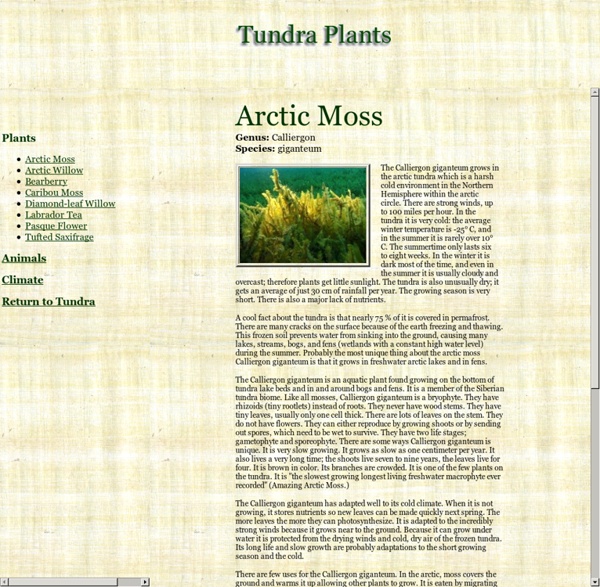



Tundra Animals Fact The Tundra Biome Tundra is the coldest of all the biomes. Tundra comes from the Finnish word tunturia, meaning treeless plain. It is noted for its frost-molded landscapes, extremely low temperatures, little precipitation, poor nutrients, and short growing seasons. Dead organic material functions as a nutrient pool. Characteristics of Tundra Extremely cold climate Low biotic diversity Simple vegetation structure Limitation of drainage Short season of growth and reproduction Energy and nutrients in the form of dead organic material Large population oscillations Arctic Arctic tundra is located in the northern hemisphere, encircling the north pole and extending south to the coniferous forests of the taiga. AlpineAlpine tundra is located on mountains throughout the world at high altitude where trees cannot grow.
Interesting facts Fact Tundra - Wikipedia In physical geography, tundra is a type of biome where the tree growth is hindered by low temperatures and short growing seasons. The term tundra comes through Russian тундра (tûndra) from the Kildin Sami word tūndâr "uplands", "treeless mountain tract".[1] There are three types of tundra: Arctic tundra,[2] alpine tundra,[2] and Antarctic tundra.[3] In tundra, the vegetation is composed of dwarf shrubs, sedges and grasses, mosses, and lichens. Scattered trees grow in some tundra regions. Arctic Tundra tends to be windy, with winds often blowing upwards of 50–100 km/h (30–60 mph). The biodiversity of tundra is low: 1,700 species of vascular plants and only 48 species of land mammals can be found, although millions of birds migrate there each year for the marshes.[5] There are also a few fish species. Due to the harsh climate of Arctic tundra, regions of this kind have seen little human activity, even though they are sometimes rich in natural resources such as oil and uranium. Antarctic
Five Terms Plant Tundra -- National Geographic Tundras are among Earth's coldest, harshest biomes. Tundra ecosystems are treeless regions found in the Arctic and on the tops of mountains, where the climate is cold and windy and rainfall is scant. Tundra lands are snow-covered for much of the year, until summer brings a burst of wildflowers. Mountain goats, sheep, marmots, and birds live in mountain, or alpine, tundra and feed on the low-lying plants and insects. The Arctic tundra, where the average temperature is 10 to 20 degrees Fahrenheit (-12 to -6 degrees Celsius), supports a variety of animal species, including Arctic foxes, polar bears, gray wolves, caribou, snow geese and musk-oxen. The few plants and animals that live in the harsh conditions of the tundra are essentially clinging to life. The Arctic tundra is changing dramatically due to global warming. With global warming, the fall freeze comes later and more of the permafrost is melting in the southern Arctic.
Plant